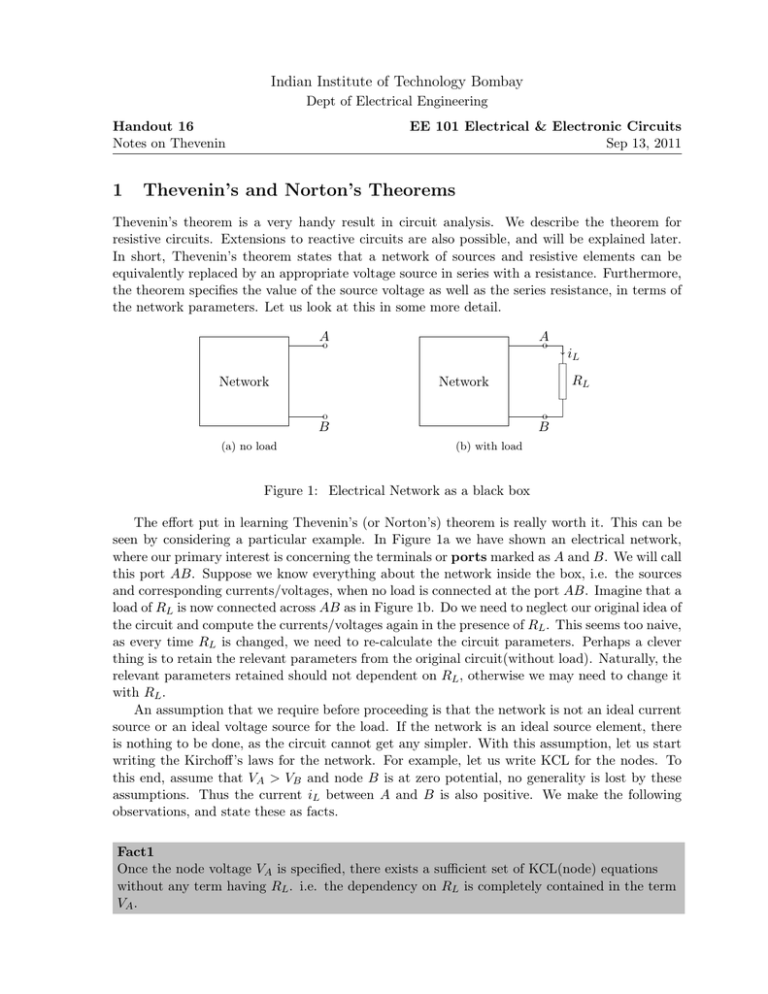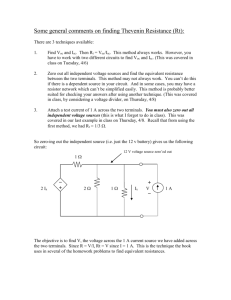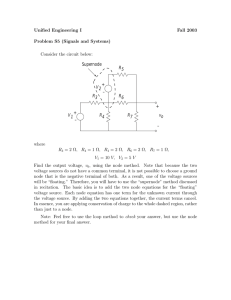1 Thevenin`s and Norton`s Theorems
advertisement

Indian Institute of Technology Bombay Dept of Electrical Engineering Handout 16 Notes on Thevenin 1 EE 101 Electrical & Electronic Circuits Sep 13, 2011 Thevenin’s and Norton’s Theorems Thevenin’s theorem is a very handy result in circuit analysis. We describe the theorem for resistive circuits. Extensions to reactive circuits are also possible, and will be explained later. In short, Thevenin’s theorem states that a network of sources and resistive elements can be equivalently replaced by an appropriate voltage source in series with a resistance. Furthermore, the theorem specifies the value of the source voltage as well as the series resistance, in terms of the network parameters. Let us look at this in some more detail. A A o Network (a) no load o iL RL Network o o B B (b) with load Figure 1: Electrical Network as a black box The effort put in learning Thevenin’s (or Norton’s) theorem is really worth it. This can be seen by considering a particular example. In Figure 1a we have shown an electrical network, where our primary interest is concerning the terminals or ports marked as A and B. We will call this port AB. Suppose we know everything about the network inside the box, i.e. the sources and corresponding currents/voltages, when no load is connected at the port AB. Imagine that a load of RL is now connected across AB as in Figure 1b. Do we need to neglect our original idea of the circuit and compute the currents/voltages again in the presence of RL . This seems too naive, as every time RL is changed, we need to re-calculate the circuit parameters. Perhaps a clever thing is to retain the relevant parameters from the original circuit(without load). Naturally, the relevant parameters retained should not dependent on RL , otherwise we may need to change it with RL . An assumption that we require before proceeding is that the network is not an ideal current source or an ideal voltage source for the load. If the network is an ideal source element, there is nothing to be done, as the circuit cannot get any simpler. With this assumption, let us start writing the Kirchoff’s laws for the network. For example, let us write KCL for the nodes. To this end, assume that VA > VB and node B is at zero potential, no generality is lost by these assumptions. Thus the current iL between A and B is also positive. We make the following observations, and state these as facts. Fact1 Once the node voltage VA is specified, there exists a sufficient set of KCL(node) equations without any term having RL . i.e. the dependency on RL is completely contained in the term VA . Fact2 Once the load current iL is specified, Kirchoff’s law equations can be made to depend on RL only through iL , i.e. they can be made independent of RL , if iL is given. Fact3 By our assumption that VA > 0 (and VB = 0), the node voltage VA is an increasing function of RL , which implies that VA decreases as the load current iL increases. Fact 1 can be easily validated by writing the KCL equations. Once VA is known, there is no need for node equations at A, and RL enters the equations only through the nodal analysis of A (recall that VB = 0). Fact 3 implicitly uses the idea that for a given network, the load current is changed only by a change in load resistance, with all other elements of the network unchanged. Using Fact 1, from the point of view of the load, the entire network can be replaced by any circuit whose dependency on RL is just in providing a node voltage of VA (RL )1 . With the correct VA value, no parameter inside the network is disturbed as the KCL equations are unchanged. So the question boils down to, is there a simple circuit which can generate a node voltage of VA (RL )?. Let V1 , V2 , · · · , Vk be the rest of the independent node voltages. Using KCL or nodal analysis at the above nodes, we get V1 f1 · · · = T (1) · Vk fk k × k+1 VA k×1 where f1 , f2 , · · · , fk are functions (in amperes) of the sources(voltage or current) in the network, which are completely known in advance. Notice that we wrote only k node equations, i.e. node equation at A is not included in the set of equations above. Let us now write the equation for node A, where we will assume that iL is the current flowing through the load. k X αi Vi + βVA = iL + i=1 k X γi fi , i=1 where αi , γi , β are functions of the given network parameters. The last term in the RHS represents the total current contribution from the sources which are connected to node A, let us denote this term by ∆s . Thus, the KCL equations are V1 f1 · · T · = · (2) Vk fk α1 · · αk β iL + ∆s VA Since this is a solvable set of equations, by taking the inverse, VA = R0 iL + k X ai fi i=1 1 we use VA (RL ) to explicitly show the dependency on RL , but will shorten this as VA to save space 2 where the constants ai , 1 ≤ i ≤ k and R0 are appropriately chosen. From our stated Fact 3, P R0 ≤ 0, so we rename RT h = −R0 . Let us also give a name to ki=1 ai fi , since it has the units of voltage, let us call it VT h . VA = VT h − iL RT h Thus we obtained an equivalent representation of the network from the point of view of the load, which is depicted in figure. Notice that VT h and RT h has nothing to do with the load RL (observe that there is no RL in Equation (2)). A RT h + − VT h B When we open-circuit the load VA = Voc , and we can identify VT h = Voc . On the other hand, while short-circuiting the load, VT h RT h = , Isc where Isc is the short-circuit current. Proposition 1 Voc Isc is the equivalent resistance of the network from A to B. Recall that the equivalent resistance can be found by setting all independent sources to zero, and then applying a test voltage. Let us apply a test voltage of VT h = Voc . First assume that the independent sources are left as it is. In this case, there will be no effective current entering/leaving the test source through node A or B. This is because there is no potential difference between terminals at either side of the port AB. Applying the superposition principle, the current driven by the test source into the network is exactly canceled by that driven by the sources inside the network through the load terminals. But what is the current driven by sources of the network through AB. By superposition, we can find this current by short-circuiting AB, i.e Isc is the current supplied by the sources inside the network. Thus Voc will drive a current equal to the negative of Isc into the network, when all other independent sources are set to zero. oc Hence VIsc is nothing but the effective resistance from A to B, which is computed by applying Voc as the test voltage. Norton’s theorem can be showed merely as a corollary of Thevenin’s by employing source transformations. You should however, observe that if the circuit is effectively a current source, only Norton’s representation exists. Similarly an equivalent voltage source network will have only Thevenin’s representation. 3




